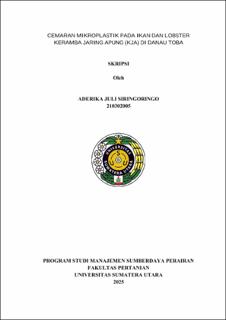| dc.description.abstract | Microplastic contamination in aquatic environments has become a
significant global issue, affecting both ecosystems and human health. This study
aims to identify the presence, abundance, and types of microplastics in fish species
such as Cyprinus carpio (common carp), Oreochromis niloticus (Nile tilapia),
Clarias batrachus (walking catfish), Oreochromis mossambicus (Mozambique
tilapia), Amphilophus labiatus (red devil cichlid), and Cherax quadricarinatus (red
claw crayfish) cultivated in floating net cages (KJA) in Lake Toba. The research
was conducted at various stations around the lake, collecting samples for
laboratory analysis.The results indicate that microplastic particles, including
fragments, fibers, films, foams, and Pelets, were found in the digestive organs and
tissues of the studied aquatic organisms. The highest microplastic abundance in the
digestive organs was found in Oreochromis mossambicus (66.66 particles/gram)
during the dry season and in Cherax quadricarinatus (290 particles/gram) during
the rainy season. In the muscle tissue, the highest microplastic abundance was
found in Oreochromis niloticus (35 particles/gram) during the dry season and in
Cherax quadricarinatus (65 particles/gram) during the rainy season. The most
common type of microplastic identified was fragments, with varying concentrations
depending on location and season. The findings highlight the potential risks of
microplastic contamination in aquaculture and the need for further research and
environmental management strategies to mitigate its impact | en_US |


